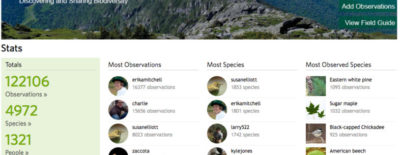Every grasshopper, cricket or katydid you find counts — from the common to the rare. Even if you lack experience with these insects, you can contribute to the atlas. Report your sightings (both photographs or sound recordings) to iNaturalist Vermont. If you have a collection or historical records and would like to contribute those to the atlas, please contact us. We'd love to help you publish your data!
Photography
Often a photograph is all you need to submit a valuable record. Here are some tips on how to provide us with the best evidence.
- Close-ups are the best, but sometimes even a distant image will do.
- Photograph them from a few different angles: top, side, front. If your camera has a macro setting (often indicated by a tulip symbol) be sure to use it so you can focus on it closely for the most detail.
- Even a poor photo may be good enough for identification, so don’t worry if you don’t have the perfect image; you can still share it.
We asked expert Brandon Woo, who identifies a lot of Vermont records on iNaturalist, if he would give some advice on how to share photographs that would best help ID species. He made this amazing guide to help all of us. Check it out on Bugguide.net
Sound Recordings
- Many species of cricket and katydid can be identified by just their calls. These can be uploaded to iNaturalist too! You can even use a smartphone to get recordings. But remember to get as close as you can.
- Make sure you indicate the air temperature at the time of recording as a comment with your iNaturalist observation. Many species change speed of calls by temperature.
- If possible, record as .WAV format. This is uncompressed and will not filter some sounds like MP3 or other file types will.
Identifying Orthoptera
Some species can be tricky. But with a bit of practice and patience, you can learn to identify many of Vermont’s species. Here are a few great guides to help you:







